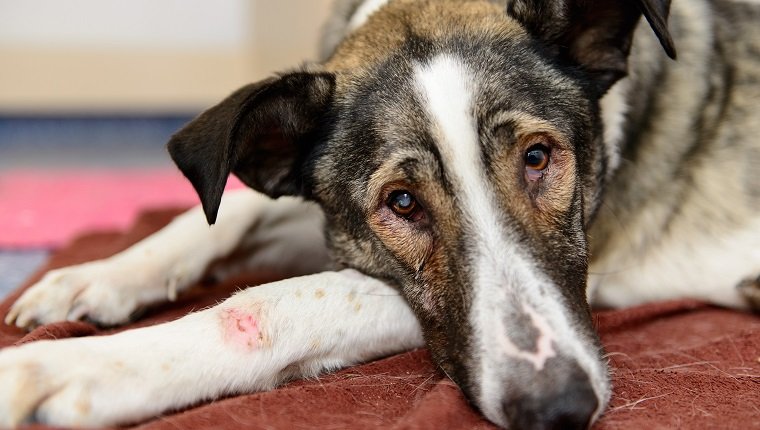Aggression to Unfamiliar People or Dogs
A variety of different motivations exist, including fear, territoriality, conflict, and possessiveness. Aggression is directed toward a person or dog that does not live in the household. Regular visitors may also be targets. Maybe within the range of normal behavior, but maybe compounded by fearfulness. Numerous functional types have been posited.
Can occur at any age. Signs may begin to emerge as primary socialization wanes (approximately 12–16 weeks of age) or may arise or intensify at social maturity (approximately 18–36 months). Genetic concerns and poor prognosis if signs arise before 12 weeks.
Territorial aggression more common in intact males—initial signs usually present by 1 year.
Aggression toward unfamiliar people and dogs overrepresented in males.
Breed predilection for inter-dog aggression in “fighting breeds” (e.g., pit bull terriers) and terriers.
SIGNS
Aggression (barking, growling, lip-lifting, snarling, snapping, lunging, biting) toward unfamiliar people and dogs. May be accompanied by fearful or submissive body postures/facial expressions (head down, crouching, backing away, ears back, tail tucked, looking away, lip licking) or confident body postures (standing straight up, approach with tail up, ears forward).
Territorial aggression arises in familiar locations or spaces (e.g., home, yard, car).
Maybe confident, fearful, or conflict.
Fear aggression is more likely when a dog is cornered or cannot escape.
Maybe more frequent or severe on than off-leash.
CAUSES & RISK FACTORS
Maybe normal canine behavior.
Strongly influenced by previous experience (e.g., early socialization, painful conditions, rough handling, and inappropriate punishment, previous fear-evoking experience with unfamiliar people or dogs).
Underlying medical conditions, especially pain.
SAFETY RECOMMENDATIONS
Owners’ main responsibility is safety by avoiding situations that may evoke a fearful or aggressive reaction. Avoidance is also necessary to ensure the pet’s welfare and prevent further learning of aggressive behaviors.
Owners should be advised that dog owners may be liable for bites and could face civil/criminal prosecutions should a person be injured.
Successful treatment is more likely if a period of preventing exposure to aggression-provoking stimuli is instituted prior to behavior modification.
Confine the dog away from potential victims, avoid walks or parks where stimulus exposure might occur or have a dog under the direct physical control of a responsible adult whenever an aggression-provoking situation could arise (e.g., public location, when visitors are at the house).
Confine territorial dogs to where they cannot see/hear visitors approaching territory before they become aggressively aroused.
Introduce a head halter (e.g., Gentle Leader) and basket muzzle for easier and safer control.
Owners should be advised that punishment/dominance-based training can lead to increased aggression, fear, agitation, and/or injuries and should be avoided. If safety cannot be ensured, dogs should be removed from the household.
BEHAVIOR THERAPY
Structured interactions (also known as learning to earn or say please by sitting) where the dog is consistently taught to sit for anything it values (before feeding, petting, play, going for a walk) gives the dog control of its resources by sitting calmly, provides structure and predictability in all interactions, teaches impulse control and trains the dog that good things happen by sitting calmly.
Commands: teach the dog to focus on the owner for guidance using eye contact and hand target (e.g., dog touch nose to owner’s hand).
Teach the dog to sit and relax on verbal cue in neutral situations using food rewards; teach to go to the mat, bed or crate to settle; teach to walk on a loose leash. Train with a head halter or muzzle if needed to ensure safety. Private session with a force-free trainer should be considered to achieve basics before any exposure.
There are no medications licensed for the treatment of canine aggression. Owners must be aware that the use of medications is off-label.
Note in the patient’s record that owners were informed of potential risks and side effects. A signed informed consent form is advisable.
NEVER use medications without concurrent behavior modification.
Before prescribing medication, be sure that owners understand the risks and liability in owning an aggressive dog, will follow safety procedures, and do not expect medications to ensure safety.
In fact, medication may not be appropriate in all situations (e.g., households with small children, or individuals that have disabilities).
There is a strong placebo effect when using drugs for behavior therapy in dogs. Studies have not shown a robust effect of drug treatment on aggression.
PREVENTION/AVOIDANCE
Treatment recommendations are life-long—aggression may recur with treatment lapses and continued exposure to fear- and aggression-producing stimuli. Owners must always be vigilant and in control of the dog’s behavior.
Appropriate early socialization and habituation may help prevent fear-based behaviors later in life. Puppies that are not socialized during the first three months of life are more likely to be fearful, defensive, and possibly aggressive later in life. Socialization may include attending well-structured, positive reinforcement puppy classes starting during the sensitive period for socialization from 7–12 weeks (perhaps up to 14–16 weeks). One study found that vaccinated puppies that attended puppy socialization classes were at no increased risk of parvovirus.

